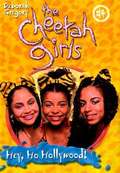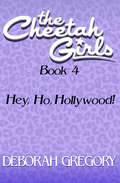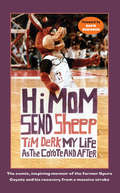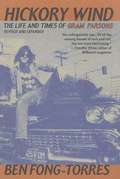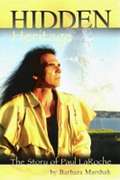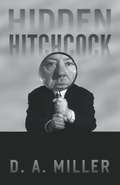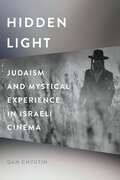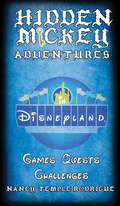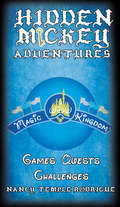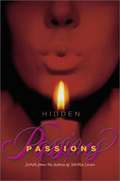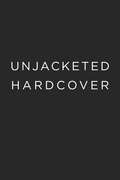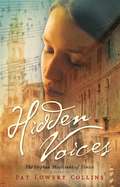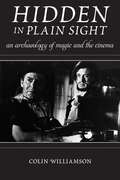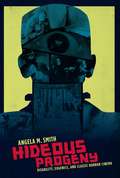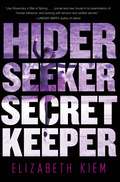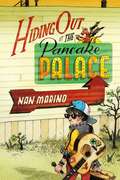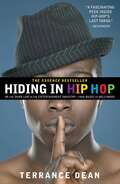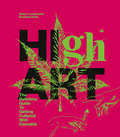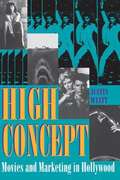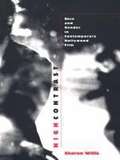- Table View
- List View
Hey, Ho, Hollywood (Cheetah Girls #4)
by Deborah GregoryKahlua is coming to town. The Cheetahs hatch a plan "Mission Kahlua," in which they rock their newest song, "More Pounce to the More... Ounce." The girls are ready to prove that every cheetah has its day!
Hey, Ho, Hollywood!: Hey, Ho, Hollywood (The Cheetah Girls #4)
by Deborah GregoryIn the fourth installment of the series that inspired the Disney Channel films, the unstoppable teens take the next step to pop stardom: La La Land! The hairdresser of Galleria&’s mom, Pepto B., gets a tip. Kahlua, the teenage R&B diva whose last single topped the charts, is coming to town. The Cheetahs hatch a plan—&“Mission Kahlua&”—in which they rock Pepto B.&’s salon with their newest song, &“More Pounce to the Ounce.&” Kahlua hooks up a meeting with her record label executives in Hollywood. The girls snag a record deal and are ready to prove to the world that every cheetah has its day! Praise for the Cheetah Girls series &“A new series just for &‘divettes-in-training&’ . . . A light read for young teens who dream of stardom.&” —School Library Journal
Hey, Kid! Does She Love Me?
by Harry MazerJeff's life would be so much better if he were the one directing it Close-up: Mary running toward him with tears in her eyes. "Oh, my darling, I couldn't wait to get back." Cut to long shot: Jeff puts his arms around her. They kiss. Fade out. Jeff already sees everything as a scene in a movie, planning the camera angles and imagining people reading the lines he'll write for them. As soon as he saves up enough money to move to California, he's going to quit his dishwashing job, and then . . . look out for Director Orloff! Unfortunately, Mary Silver doesn't seem to have read the script. When they were in high school drama club together, she never noticed Jeff, and now that she's back in town, a new player has entered the scene: Mary's infant daughter, Hannah. Being a mom is a full-time job, but Jeff knows that Mary was born to be an actress--he's seen her come alive on stage, transforming into her character from the inside out. Her kind of talent is in a class by itself. If only Mary could see herself as Jeff sees her--beautiful and talented . . . and utterly in love with him. Will their romance always be just in his head? Or can he win Mary's heart another way--by figuring out what it means to be a friend to her, and to Hannah?
Hi Honey, I'm Homo!: Sitcoms, Specials, and the Queering of American Culture
by Matt BaumeLambda Literary Award Winner for LGBTQ+ Nonfiction 2024 Stonewall Book Honor Award Winner—Israel Fishman Non-Fiction Book Award Featured on NPR's Books We Love 2023 One of Vulture's Best Comedy Books of 2023 "This book is a triumph and everyone should read it." —Dan Savage, journalist and author, on the "Savage Lovecast" "Hi Honey, I&’m Homo is a heartbreaking historical document, but ultimately one that will leave the reader feeling proud of how something as maligned and disposable as the network sitcom used comedy to bring about such profound and important social progress." —Vulture "[A] well-curated compendium of prime time broadcasting . . . Baume is a companionable guide." —Shelf Awareness Behind the scenes of the most popular sitcoms of the 20th century, a revolution was brewing. For decades, amidst the bright lights, studio-audience laughs, and absurdly large apartment sets, the real-life story of American LGBTQ+ liberation unfolded in plain sight in front of millions of viewers, most of whom were laughing too hard to mind. From flamboyant relatives on Bewitched to closely-guarded secrets on All in the Family, from network-censor fights over Soap to behind-the-scenes activism on the set of The Golden Girls, from Ellen&’s culture clash and Will & Grace&’s mixed reception to Modern Family&’s primetime power-couple, Hi Honey, I&’m Homo! is the story not only of how subversive queer comedy transformed the American sitcom, from its inception through today, but how our favorite sitcoms transformed, and continue to transform, America. Accessible, entertaining, and informative, Hi Honey, I&’m Homo! features commentary and interviews from celebrities, behind-the-scenes creators, and more.
Hi Mom, Send Sheep!
by David Robinson Tim DerkAt 47, Tim Derk had long been the San Antonio Spur's crowd-pleasing Coyote and was widely regarded as the NBA's funniest, most inventive mascot. Then, as the Spurs were headed toward their third championship, Derk suffered a massive stroke and his seemingly charmed existence was shattered. Here, he recounts his courageous battle to recover from the stroke's devastating impact, both on his body and his career. Amusing reminiscences of Spurs' players and owners, and of his own on-court hijinks, enliven Derk's uplifting tale of stroke survival.
Hi Mom, Send Sheep!
by David Robinson Tim DerkAt 47, Tim Derk had long been the San Antonio Spur's crowd-pleasing Coyote and was widely regarded as the NBA's funniest, most inventive mascot. Then, as the Spurs were headed toward their third championship, Derk suffered a massive stroke and his seemingly charmed existence was shattered. Here, he recounts his courageous battle to recover from the stroke's devastating impact, both on his body and his career. Amusing reminiscences of Spurs' players and owners, and of his own on-court hijinks, enliven Derk's uplifting tale of stroke survival.
Hickory Wind: The Life and Times of Gram Parsons
by Ben Fong-TorresFrom Publishers Weekly This entertaining biography examines the eventful life of singer/guitarist Gram Parsons, who collaborated with the Byrds on the album Sweetheart of the Rodeo , founded the Flying Burrito Brothers with Chris Hillman and worked with country singer Emmylou Harris. Although Parsons achieved only minimal stardom prior to his 1973 drug-related death at age 26, his fusion of country and rock influenced such bands as the Eagles and the Grateful Dead. Fong-Torres ( The Motown Album ) describes the free-spirited, flamboyant musician's privileged but troubled Southern background and interviews individuals including the Byrds' Roger McGuinn, the Rolling Stones' Keith Richards and loyal road manager Phil Kaufman, who, according to Parsons's wishes, attempted--unsuccessfully--to cremate Parsons's body in Joshua Tree National Monument, a park in California. Fong-Torres drops music-biz names and reports on the colorful 1960s and '70s fast lane with finesse; Parsons's profound, continuing impact is felt in admiring testimonies from friends and fans.
Hidden Heritage: The Story of Paul Laroche
by Barbara MarshakA spiritual legacy of one man's ordinary Minnesota lifestyle, suddenly fused with a rich, Lakota heritage that enabled him to cross boundaries far beyond his own expectations. Imagine waking up one day to discover you belong to a completely different culture. Paul Summers, a 38-year-old father of two, has just discovered that his birth mother was a member of the Lakota tribe from South Dakota. Drained physically, emotionally, and financially following his attempts to pursue a career in music, Paul hits rock bottom.
Hidden Hitchcock
by D. A. MillerNo filmmaker has more successfully courted mass-audience understanding than Alfred Hitchcock, and none has been studied more intensively by scholars. In Hidden Hitchcock, D. A. Miller does what seems impossible: he discovers what has remained unseen in Hitchcock's movies, a secret style that imbues his films with a radical duplicity. Focusing on three films--Strangers on a Train, Rope, and The Wrong Man--Miller shows how Hitchcock anticipates, even demands a "Too-Close Viewer." Dwelling within us all and vigilant even when everything appears to be in good order, this Too-Close Viewer attempts to see more than the director points out, to expand the space of the film and the duration of the viewing experience. And, thanks to Hidden Hitchcock, that obsessive attention is rewarded. In Hitchcock's visual puns, his so-called continuity errors, and his hidden appearances (not to be confused with his cameos), Miller finds wellsprings of enigma. Hidden Hitchcock is a revelatory work that not only shows how little we know this best known of filmmakers, but also how near such too-close viewing comes to cinephilic madness.
Hidden Light: Judaism and Mystical Experience in Israeli Cinema (Contemporary Approaches to Film and Media Series)
by Dan ChyutinOver the past several decades, the prevailing attitude toward Judaism in Israeli society has undergone a meaningful shift; where the national ethos had once deemed Judaic traditions a vestige of an arcane past incompatible with the culture of a modern state, there is now greater acceptance of these traditions by a sizeable part of Israeli society. Author Dan Chyutin reveals this trend through a parallel shift toward acceptance and celebration of Judaic identity and lifestyle in modern Israeli cinema. Hidden Light explores the Judaic turn in contemporary Israeli filmmaking for what it can tell us about Israel’s cultural landscape, as well as about the cinematic medium in general. Chyutin points to the ambivalence of films which incorporate Judaism into Israel’s secular ethos; concurrently, he foregrounds the films' attempt to overcome this ambivalence through reference to and activation of experiences of transcendence and unity, made popular by New Age–inflected understandings of Jewish mystical thought. By virtue of this exploration, Judaic-themed Israeli cinema emerges as a crucial example of how film’s particular form of "magic" may be exploited for the purpose of affecting mystical states in the audience.
Hidden Mickey Adventures in Disneyland
by Nancy Temple RodrigueEXPLORE DISNEYLAND® IN A WHOLE NEW WAY See your favorite Park with a new set of eyes! GAMES, PUZZLES and CHALLENGES AWAIT AS YOU RACE THROUGH DISNEYLAND® Work alone, with friends, or team up and challenge them. Score Points on each quest you finish. See who knows the park the best as you decipher cryptic clues and find hidden symbols. TEST YOUR KNOWLEDGE OF THE MAN THAT STARTED IT ALL: WALT DISNEY Almost all the scavenger hunts are handicap accessible. FUN FOR ALL AGES! From the author of the acclaimed Hidden Mickey Adventures series. HIDDEN MICKEY ADVENTURES: in Disneyland is the start of the Hidden Mickey Adventures series, where readers will enjoy more action-adventure mysteries about Walt Disney and Disneyland®
Hidden Mickey Adventures in WDW Magic Kingdom
by Nancy Temple RodrigueEXPLORE WALT DISNEY WORLD MAGIC KINGDOM® IN A WHOLE NEW WAY See your favorite Park with a new set of eyes! GAMES, PUZZLES and CHALLENGES AWAIT AS YOU RACE THROUGH W D W MAGIC KINGDOM® Work alone, with friends, or team up and challenge them. Score Points on each quest you finish. See who knows the park the best as you decipher cryptic clues and find hidden symbols. TEST YOUR KNOWLEDGE OF THE MAN THAT STARTED IT ALL: WALT DISNEY Almost all the scavenger hunts are handicap accessible. FUN FOR ALL AGES! From the author of the acclaimed Hidden Mickey Adventures series. HIDDEN MICKEY ADVENTURES: in WDW Magic Kingdom is part of the Hidden Mickey Adventures series, where readers will enjoy more action-adventure mysteries about Walt Disney and Disneyland®
Hidden Passions: Secrets From The Diaries Of Tabitha Lenox
by Tabitha LenoxOn the surface, this seaside town is a New England dream of cobblestone streets and charming colonial homes. In its sleepy little harbor, fishing trawlers bob next to pleasure yachts on sun-drenched waves. But beneath the picture-perfect waters and walkways lie tumultuous secrets that threaten to tear Harmony's families apart. Hidden Passions turns back the clock in the quant town more than twenty years to reveal the intimate details of those secrets.. Sam Bennett is the hardworking son of the town's police chief. Handsome and well built, he catches the eye of every woman in town. Unfortunately, his heart belongs to one who will break it.. Eve Johnson is an upstanding premed student who on a lark decides to pursue a private fantasy -- one that could ravage her life... Julian Crane is a wealthy law student who is desperate to marry the beautiful Ivy Winthrop, but the reason why could shatter Ivy's happiness forever.. T.C. Russell lives to become a tennis pro, but his heartfelt dream is about to be smashed in a way no one would ever suspect.. Grace Standish is a home-schooled farm girl who wants nothing more than to live a peaceful life in the country until her mother reveals a shocking secret... Only one woman knows the intimate details of all their stories. While everyone in Harmony believes this woman is nothing more than a harmless eccentric, the truth is that she is an irrepressible sorceress of darkness who's been causing trouble in Harmony even before Prudence Standish accused her of being a witch in 1693 -- a grudge this society shameness still holds today! She has always known the hidden passions of every man, woman, and child in this quiet harbor town. But only now is she ready to reveal that tantalizing details to you. So turn off the Coast Road and enter Harmony...but be very careful if you should encounter a mysterious woman carrying a doll. As she's done with Harmoney townfolk for hundreds of years, she may very well look into your heart to see what it is you truly desire and grant it -- for a terribly high price
Hidden Talent: The Emergence of Hollywood Agents
by Tom KemperThis is a history of Hollywood agents as they rose in the studio system in the late 1920s and early 1930s up through the 1940s, demonstrating the central role they played in the classical Hollywood period. Includes bibliographical references and index.
Hidden Voices: The Orphan Musicians of Venice
by Pat Lowery CollinsWhile studying under Vivaldi, three girls in a Venice orphanage forge their own notions of love in a sensuous, engrossing novel told in three narrative voices. It is a longing search for love that motivates three girls living in the Ospedale della Pietà, an orphanage renowned for its extraordinary musical program. But for Rosalba, Anetta, and Luisa, the love they seek is not where they expect to find it. Set in the early 1700s in the heart of Venice, this remarkable novel deftly weaves the history of Antonio Vivaldi's early musical career into the lives of three young women who excel in voice and instrument. Under the composer's tutelage and care, the orphans find expression, sustenance, and passion. But can the sheltered life of the orphanage prepare them for the unthinkable dangers outside its walls?
Hidden in Plain Sight
by Colin WilliamsonWhat does it mean to describe cinematic effects as "movie magic," to compare filmmakers to magicians, or to say that the cinema is all a "trick"? The heyday of stage illusionism was over a century ago, so why do such performances still serve as a key reference point for understanding filmmaking, especially now that so much of the cinema rests on the use of computers? To answer these questions, Colin Williamson situates film within a long tradition of magical practices that combine art and science, involve deception and discovery, and evoke two forms of wonder--both awe at the illusion displayed and curiosity about how it was performed. He thus considers how, even as they mystify audiences, cinematic illusions also inspire them to learn more about the technologies and techniques behind moving images. Tracing the overlaps between the worlds of magic and filmmaking, Hidden in Plain Sight examines how professional illusionists and their tricks have been represented onscreen, while also considering stage magicians who have stepped behind the camera, from Georges Méliès to Ricky Jay. Williamson offers an insightful, wide-ranging investigation of how the cinema has functioned as a "device of wonder" for more than a century, while also exploring how several key filmmakers, from Orson Welles to Christopher Nolan and Martin Scorsese, employ the rhetoric of magic. Examining pre-cinematic visual culture, animation, nonfiction film, and the digital trickery of today's CGI spectacles, Hidden in Plain Sight provides an eye-opening look at the powerful ways that magic has shaped our modes of perception and our experiences of the cinema.
Hide in Plain Sight
by Paul Buhle Dave WagnerHide in Plain Sight completes Buhle and Wagner's trilogy on the Hollywood blacklist. When the blacklistees were hounded out of Hollywood, some left for television where many worked on children's shows like "Rocky and Bullwinkle." A number wrote adult sitcoms such as The Donna Reed Show, and M*A*S*H while some of them ultimately returned to Hollywood and made great films such as Norma Rae, and Midnight Cowboy. This is a thoughtful look at the rising fear of communism in America and the aftermath of the horror that was the McCarthy period, from two expert historians of the blacklist period.
Hideous Progeny: Disability, Eugenics, and Classic Horror Cinema
by Angela M. SmithTwisted bodies, deformed faces, aberrant behavior, and abnormal desires characterized the hideous creatures of classic Hollywood horror, which thrilled audiences with their sheer grotesqueness. Most critics have interpreted such traits as symptoms of sexual repression, or as metaphors for other kinds of marginalized identities, but Angela M. Smith conducts a richer investigation into the period's social and cultural preoccupations. Presenting an altogether different reading, she finds in the narrative and spectacle of classic 1930s horror a fascination with eugenics and physical and cognitive debility, heightened by viewers' own desire for visions of vulnerability and transformation.
Hideous Progeny: Disability, Eugenics, and Classic Horror Cinema (Film and Culture Series)
by Angela SmithTwisted bodies, deformed faces, aberrant behavior, and abnormal desires characterized the hideous creatures of classic Hollywood horror, which thrilled audiences with their sheer grotesqueness. Most critics have interpreted these traits as symptoms of sexual repression or as metaphors for other kinds of marginalized identities, yet Angela M. Smith conducts a richer investigation into the period's social and cultural preoccupations. She finds instead a fascination with eugenics and physical and cognitive debility in the narrative and spectacle of classic 1930s horror, heightened by the viewer's desire for visions of vulnerability and transformation. Reading such films as Dracula (1931), Frankenstein (1931), Dr. Jekyll and Mr. Hyde (1931), Freaks (1932), and Mad Love (1935) against early-twentieth-century disability discourse and propaganda on racial and biological purity, Smith showcases classic horror's dependence on the narratives of eugenics and physiognomics. She also notes the genre's conflicted and often contradictory visualizations. Smith ultimately locates an indictment of biological determinism in filmmakers' visceral treatments, which take the impossibility of racial improvement and bodily perfection to sensationalistic heights. Playing up the artifice and conventions of disabled monsters, filmmakers exploited the fears and yearnings of their audience, accentuating both the perversity of the medical and scientific gaze and the debilitating experience of watching horror. Classic horror films therefore encourage empathy with the disabled monster, offering captive viewers an unsettling encounter with their own impairment. Smith's work profoundly advances cinema and disability studies, in addition to general histories concerning the construction of social and political attitudes toward the Other.
Hider, Seeker, Secret Keeper
by Elizabeth KiemLana travels to New York City, on tour dancing with the world famous Bolshoi Ballet in this thrilling follow up to Dancer, Daughter, Traitor, Spy.Lana Dukovskaya has spent her life in her mother, Marina's, shadow, and nowhere more so than at Russia's world-famous Bolshoi ballet, where Marina danced years ago. But when Daniela, Lana's friend and chief rival, is brutally attacked on the eve of a New York tour, Lana is given her coveted solo--an unlikely stroke of luck that makes Lana the chief suspect in the attack. Once in New York, Lana meets Georgi Levshik, a powerful Russian émigré who claims to know the truth about Marina's past. She's torn between her distrust of Levshik's offered patronage and her need for answers. But when another young dancer is struck down on the day of her debut, Lana becomes the prime suspect in not one, but two attacks. On the run and still in the dark, Lana puts her trust in Levshik's alluring young bodyguard, Roma. Together they must uncover the truth about a Bolshoi blood feud involving three generations of Dukovskaya dancers.From the Hardcover edition.
Hiding Out at the Pancake Palace
by Nan MarinoWhen musical prodigy Elvis Ruby completely freezes up on television, he is forced to hide out in the Pinelands of New Jersey and try to find his way back to the music once again with the help of a new friend.
Hiding in Hip Hop: On the Down Low in the Entertainment Industry--from Music to Hollywood
by Terrance Dean&“If you&’re a fan of the hit show Empire and its characters Cookie, Lucious, Hakeem, Jamal, and Andre, then you have to check out Terrance Dean&’s provocative memoir Hiding in Hip Hop. Dean writes a compelling story about black gay men in Hip Hop and Hollywood, and what it takes for them to make it the entertainment industry.&” – JL King, New York Times bestselling author of On The Down LowCelebrated blogger and former MTV insider Terrance Dean reveals a hidden side of Hollywood and hip hop in this explosive and illuminating memoir. Terrance Dean worked his way up for more than ten years in the entertainment industry from intern to executive and has lived the life of glitz and bling along with Hollywood and Hip Hop&’s most glamorous heavy hitters. As a gay man immersed within the world of the famous and the fabulous, Dean knows well the industry&’s secrets and the façade that is kept, that for men, promotes machismo and heteronormative behavior. Most of what Dean unveils in this book is fascinating and salacious, but all of it is true. He also shares his own secrets, and an account of the pain of his mother&’s addiction, and the poverty and molestation he experienced as a child. Hiding in Hip Hop is not a traditional tell-all. It&’s personal. It&’s poignant. It&’s a provocative and honest look at stardom and sexuality.
High Art: The Definitive Guide to Getting Cultured with Cannabis
by Robert Lambrechts Estefanio HoltzArt can be confusing. Luckily, there&’s marijuana. This book pairs fifty classic works from all around the world with unique cannabis recommendations. High Art gives you answers to questions that have long plagued art history students, such as Is there an edible that will help me understand Cubism? (Yes!) Can a cannabis strain connect me more deeply to late-period Van Gogh? (Of course!) And Should I be intimidated by the work of William Blake? (Very much so—but cannabis extracts can help.)To get in touch with your inner self while viewing Van Gogh&’s Self-Portrait with a Straw Hat, toke on some of Gravita&’s Red-Headed Stranger and really feel the brush strokes wash over you. Or while viewing Henri Rousseau&’s 1910 Tropical Forest with Monkeys, you might smoke some mild Purple Monkey followed by a snack of THC-infused dried fruits for a body float that will allow you to connect with your primitive nature.So whether you know a lot about art and nothing about cannabis or a lot about cannabis and nothing about art, it&’s high time you expanded your mind.
High Concept: Movies and Marketing in Hollywood
by Justin WyattSteven Spielberg once said, "I like ideas, especially movie ideas, that you can hold in your hand. If a person can tell me the idea in twenty-five words or less, it's going to make a pretty good movie. " Spielberg's comment embodies the essence of the high concept film, which can be condensed into one simple sentence that inspires marketing campaigns, lures audiences, and separates success from failure at the box office. This pioneering study explores the development and dominance of the high concept movie within commercial Hollywood filmmaking since the late 1970s. Justin Wyatt describes how box office success, always important in Hollywood, became paramount in the era in which major film studios passed into the hands of media conglomerates concerned more with the economics of filmmaking than aesthetics. In particular, he shows how high concept films became fully integrated with their marketing, so that a single phrase ("Just when you thought it was safe to go back in the water . . . ") could sell the movie to studio executives and provide copy for massive advertising campaigns; a single image or a theme song could instantly remind potential audience members of the movie, and tie-in merchandise could generate millions of dollars in additional income.
High Contrast: Race and Gender in Contemporary Hollywood Films
by Sharon WillisIn High Contrast, Sharon Willis examines the dynamic relationships between racial and sexual difference in Hollywood film from the 1980s and 1990s. Seizing on the way these differences are accentuated, sensationalized, and eroticized on screen--most often with little apparent regard for the political context in which they operate--Willis restores that context through close readings of a range of movies from cinematic blockbusters to the work of the new auteurs, Spike Lee, David Lynch, and Quentin Tarantino.Capturing the political complexity of these films, Willis argues that race, gender, and sexuality, as they are figured in the fantasy of popular film, do not function separately, but rather inform and determine each other's meaning. She demonstrates how collective anxieties regarding social difference are mapped onto big budget movies like the Die Hard and Lethal Weapon series, Basic Instinct, Fatal Attraction, Thelma and Louise, Terminator 2, and others. Analyzing the artistic styles of directors Lynch, Tarantino, and Lee, in such films as Wild at Heart, Pulp Fiction, and Do the Right Thing, she investigates how these interactions of difference are linked to the production of specific authorial styles, and how race functions for each of these directors, particularly in relation to gender identity, erotics, and fantasy.
